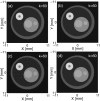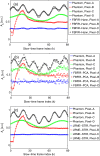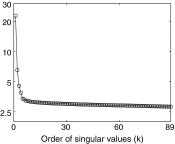Fast spatiotemporal image reconstruction based on low-rank matrix estimation for dynamic photoacoustic computed tomography
- PMID: 24817620
- PMCID: PMC4046831
- DOI: 10.1117/1.JBO.19.5.056007
Fast spatiotemporal image reconstruction based on low-rank matrix estimation for dynamic photoacoustic computed tomography
Abstract
In order to monitor dynamic physiological events in near-real time, a variety of photoacoustic computed tomography (PACT) systems have been developed that can rapidly acquire data. Previously reported studies of dynamic PACT have employed conventional static methods to reconstruct a temporally ordered sequence of images on a frame-by-frame basis. Frame-by-frame image reconstruction (FBFIR) methods fail to exploit correlations between data frames and are known to be statistically and computationally suboptimal. In this study, a low-rank matrix estimation-based spatiotemporal image reconstruction (LRME-STIR) method is investigated for dynamic PACT applications. The LRME-STIR method is based on the observation that, in many PACT applications, the number of frames is much greater than the rank of the ideal noiseless data matrix. Using both computer-simulated and experimentally measured photoacoustic data, the performance of the LRME-STIR method is compared with that of conventional FBFIR method followed by image-domain filtering. The results demonstrate that the LRME-STIR method is not only computationally more efficient but also produces more accurate dynamic PACT images than a conventional FBFIR method followed by image-domain filtering.
Figures













Similar articles
-
Spatiotemporal image reconstruction to enable high-frame-rate dynamic photoacoustic tomography with rotating-gantry volumetric imagers.J Biomed Opt. 2024 Jan;29(Suppl 1):S11516. doi: 10.1117/1.JBO.29.S1.S11516. Epub 2024 Jan 19. J Biomed Opt. 2024. PMID: 38249994 Free PMC article.
-
A survey of computational frameworks for solving the acoustic inverse problem in three-dimensional photoacoustic computed tomography.Phys Med Biol. 2019 Jul 18;64(14):14TR01. doi: 10.1088/1361-6560/ab2017. Phys Med Biol. 2019. PMID: 31067527 Review.
-
Comprehensive framework of GPU-accelerated image reconstruction for photoacoustic computed tomography.J Biomed Opt. 2024 Jun;29(6):066006. doi: 10.1117/1.JBO.29.6.066006. Epub 2024 Jun 6. J Biomed Opt. 2024. PMID: 38846677 Free PMC article.
-
Full-wave iterative image reconstruction in photoacoustic tomography with acoustically inhomogeneous media.IEEE Trans Med Imaging. 2013 Jun;32(6):1097-110. doi: 10.1109/TMI.2013.2254496. Epub 2013 Mar 22. IEEE Trans Med Imaging. 2013. PMID: 23529196 Free PMC article.
-
Spatial resolution in photoacoustic computed tomography.Rep Prog Phys. 2021 Mar 1;84(3). doi: 10.1088/1361-6633/abdab9. Rep Prog Phys. 2021. PMID: 33434890 Review.
Cited by
-
Spatiotemporal image reconstruction to enable high-frame-rate dynamic photoacoustic tomography with rotating-gantry volumetric imagers.J Biomed Opt. 2024 Jan;29(Suppl 1):S11516. doi: 10.1117/1.JBO.29.S1.S11516. Epub 2024 Jan 19. J Biomed Opt. 2024. PMID: 38249994 Free PMC article.
-
Enhancement of in vivo cardiac photoacoustic signal specificity using spatiotemporal singular value decomposition.J Biomed Opt. 2021 Apr;26(4):046001. doi: 10.1117/1.JBO.26.4.046001. J Biomed Opt. 2021. PMID: 33876591 Free PMC article.
-
Enabling high-speed wide-field dynamic imaging in multifocal photoacoustic computed microscopy: a simulation study.Appl Opt. 2016 May 10;55(14):3724-9. doi: 10.1364/AO.55.003724. Appl Opt. 2016. PMID: 27168282 Free PMC article.
-
Spatiotemporal singular value decomposition for denoising in photoacoustic imaging with a low-energy excitation light source.Biomed Opt Express. 2022 Nov 14;13(12):6416-6430. doi: 10.1364/BOE.471198. eCollection 2022 Dec 1. Biomed Opt Express. 2022. PMID: 36589568 Free PMC article.
-
Adaptive enhancement of acoustic resolution photoacoustic microscopy imaging via deep CNN prior.Photoacoustics. 2023 Apr 1;30:100484. doi: 10.1016/j.pacs.2023.100484. eCollection 2023 Apr. Photoacoustics. 2023. PMID: 37095888 Free PMC article.
References
-
- Wang L. V., “Tutorial on photoacoustic microscopy and computed tomography,” IEEE J. Sel. Topics Quantum Electron. 14, 171–179 (2008).IJSQEN10.1109/JSTQE.2007.913398 - DOI
-
- Oraevsky A. A., Karabutov A. A., “Optoacoustic tomography,” Chapter 34 in Biomedical Photonics Handbook, Vo-Dinh T., Ed., pp. 34/1–34/34, CRC Press LLC, Boca Raton, FL: (2003).
Publication types
MeSH terms
Grants and funding
LinkOut - more resources
Full Text Sources
Other Literature Sources
Medical
Molecular Biology Databases
Miscellaneous

